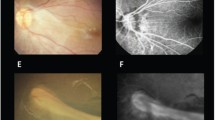Abstract
The decision to use therapy in toxoplasma retinochorioiditis depends on the location of the active lesion and the presence of vitreous activity. In eyes with dense vitreous clouding it can be difficult to see whether the macular region is involved or not. In theory the localisation of a lesion can be estimated on the basis of the flash ERG. The standard flash electroretinogram was recorded in 23 patients with inactive toxoplasma retinochorioiditis lesions in the retina. In 17 cases a lesion was present within the central 12° of the visual field, 8 of these had a reduced photopic ERG. In 15 patients lesions were found outside the central 12°, in 8 of whom the scotopic ERG was reduced. We conclude that the ERG can be of use in indicating the scar location in patients with dense vitreous clouding.
Similar content being viewed by others
References
Karpe G. The basis of clinical electroretinography. Acta Ophthalmol Scand 1945; suppl 24: 1–118.
François J. L'électro-rétinographie dans les uvéites. Ophthalmologica 1953; 125 (3): 137–43.
Algvere P. Electroretinographic studies on posterior uveitis. Acta Ophthalmol Scand 1967; 45: 299–313.
Denden A. ERG- und EOG-Untersuchungsergebnisse bei der Toxocara canis retinochorioiditis. Klin Mbl Augenheilk 1974; 165: 617–25.
Hatt M, Niemeyer G. Elektroretinographie bei Morbus Behçet. Graefes Arch Ophthalmol 1976; 198: 113–20.
Müller W, Kleinschmidt R. Zur Interpretation elektroretinographischer Befunde bei Uveitis posterior. Klin Mbl Augenheilk 1985; 186: 79–81.
Martenet AC, Niemeyer G. The electroretinogram as an indicator of severity in uveitis. In: Secchi AG, Fregoa IA, eds. Modern trends in immunology and immunopathology. Milan, Masson: 1989.
Ikeda H, Franchi A, Turner G, Shilling J, Graham E. Electroretinography and electrooculography to localize abnormalities in early-stage inflammatory eye disese. Doc Ophthalmol 1990; 73: 387–94.
Algevere P, Hedin A, Kock E. The electroretinogram and histopathology in experimental uveitis in the pigeon. Acta Ophthalmol Scand 1968; 46: 920–35.
Lawwill T, Wacker W, MacDonald R. The role of electroretinography in evaluating posterior uveitis. Am J Ophthalmol 1972; 74 (6): 1086–93.
Stanford MR, Robbins J, Suleyman S, Dumonde DC. Electroretinographic studies in experimental allergic uveitis. In: Ferraz de Oliviera LN, ed. Ophthalmology today. Amsterdam/New York: Elsevier Science Publishers 1988: 21–26.
Stanford MR, Robbins J. Experimental posterior uveitis, II: Electroretingraphic studies. Br J Ophthalmol 1988; 72: 88–96.
Marmor MF, Arden GF, Nilsson SE and Zrenner E. Standard for clinical electroretinography. Arch Ophthalmol 1989; 107: 816–19. Doc. Ophthalmol 1990; 73(4): 303–11.
Østerberg G. Topography of the layer of rods and cones in the human retina. Acta Ophthalmol 1935; 13 suppl 6: 1–9.
Curcio AC, Sloan KR, Kalina RE, Hendrickson AE. Human photoreceptor topography. J Comp Neurology 1990; 292: 497–523.
Drasdo N, Fowler CW. Non-linear projection of the retinal image in a wide angle schematic eye. Br J Ophthalmol 1974; 58: 709–14.
Hogan MJ, Alvarado JA, Weddell JE. Histology of the human eye: An atlas and textbook. Philadelphia: Saunders, 1971.
Buren, JM van. The retinal ganglion cell layer. Springfield: Thomas Publ. 1963: 1–43.
Cooper S, Creed RS, Granit R. A note on the retinal action potential of the human eye. J Physiol (London) 1933; 79: 185–90.
Fry GA, Bartley SH. The relation of stray light in the eye to the retinal action potential. Am J Physiol 1935; 111: 335–40.
Asher H. The electroretingram of the blind spot. J Physiol (London) 1951; 112: 40P.
Wirth A, Zetterström B. Effect of area and intensity on the size and shape of the electroretinogram. Br J Ophthalmol 1954; 38: 257–65.
Armington JC, Tepas DI, Kropfl WJ, Hengst WH. Summation of retinal potentials. J Opt Soc Am 1961; 51 (6): 877–86.
Arden GB, Bankes JLK. Foveal electroretinogram as a clinical test. Br J Ophthalmol 1966; 50: 740.
Brindley GS, Westheimer G. The spatial properties of the human electroretinogram. J Physiol (London) 1965; 179: 518–37.
Aiba TS, Alpern M, Maaseidvaag F. The electroretinogram evoked by the excitation of human foveal cones. J Physiol (London) 1967; 189: 43–62
Bagolini B, Daniele A, Frank M, Ravalico G. An attempt towards a new approach to localized ERG. Doc Ophthalmol 1973; 34: 57–65.
Grounauer PA, Vo Van Toi, Huber CH. ERG by localized sinusoidal stimulation. Doc Ophthalmol Proc Ser 1977; 23: 187–192.
Author information
Authors and Affiliations
Rights and permissions
About this article
Cite this article
Riemslag, F.C.C., Brinkman, C.J.J., Lunel, H.F.E.V. et al. Analysis of the electroretinogram in toxoplasma retinochorioiditis. Doc Ophthalmol 82, 57–63 (1992). https://doi.org/10.1007/BF00156994
Accepted:
Issue Date:
DOI: https://doi.org/10.1007/BF00156994




